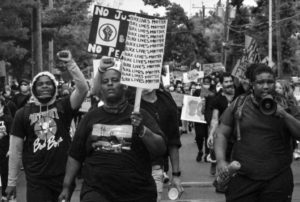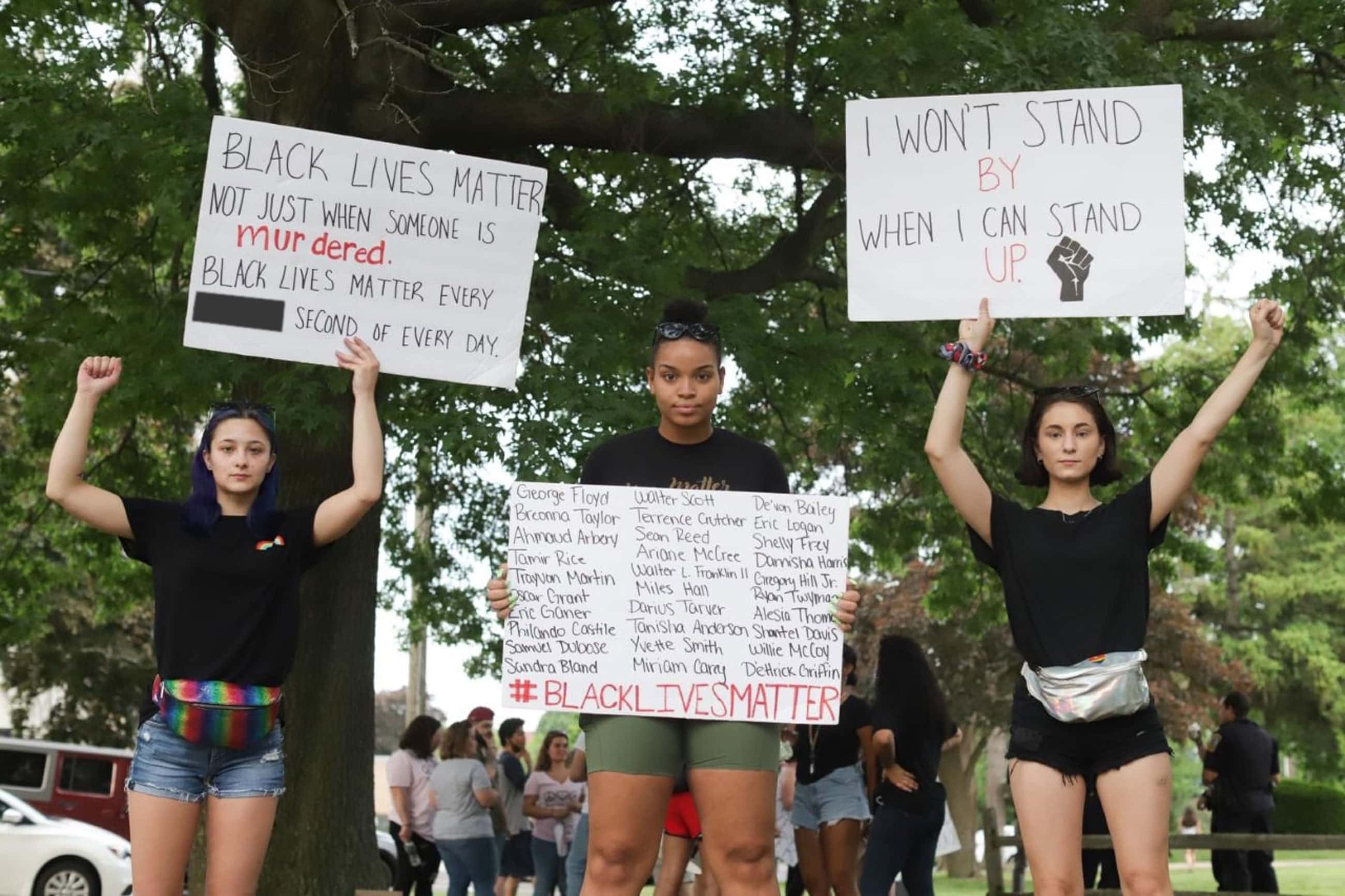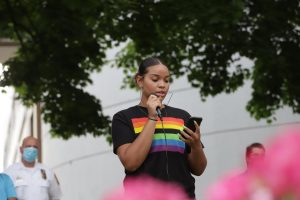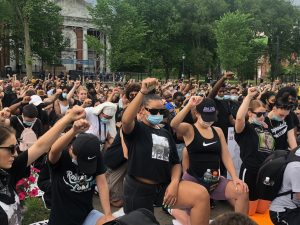Solomon James, ’22, had never organized an event in his life. “Not even a birthday party,” he says. But that was before he saw a social media post seeking support for a local march in solidarity with the Black Lives Matter movement. The gathering — to be held June 6 in his hometown of Danbury, Conn. — would echo protests throughout the nation and, indeed the world — and would provide the community with an opportunity to express anger and sorrow over the death of George Floyd, a black man killed by police during an arrest in Minneapolis on May 25.
James knew the march — kickstarted by Serenity Schreiber, a white high school student — was important. And he also knew the protest wasn’t garnering the support it warranted. So, he reached out. James is well-known in Danbury, active in sports and church. He has a large, loyal social media following. “So I said, ‘I want to help.’ I cosigned in Twitter and it got a buzz going,” he says.
After that, James hit the ground running. Despite his lack of experience, he knew one thing: the protest had to remain peaceful. “Anything else would undermine our message, and they would say, ‘See? We shouldn’t gather.’” And more than anything, James felt, now was the time to gather. Like other students at Southern Connecticut State University who are joining statewide protests and speaking out, James felt the overarching racial impact of Floyd’s death couldn’t go unaddressed.
“It’s not just George Floyd,” he says. “[These protests are] the accumulation of lifetimes and lifetimes of injustices.”
James spent the next week seeking advice and securing the appropriate permits and endorsements for the march. He made phone calls, staying up until 3 a.m. and waking at 6 a.m. He spoke with everyone from Danbury Mayor Mark Boughton and Police Chief Patrick Ridenhour to Wesley Johnson, pastor at The Gathering Community Church. He reached out to Dorothy Day Hospitality House, which supplied masks and water bottles.

When the June 6 march finally came, it started with a prayer. As protestors walked from Danbury Public Library to City Hall, they chanted in unison: “I can’t breathe” and “Say their names.” (Accounts of the numbers of attendees vary from the hundreds to the thousands.) They marched to the police station, where Chief Ridenhour fielded questions about his police force. Half the crowd then marched to I-84, where, with the help of police, the highway was shut down for an hour.
Standing on the highway, James could feel the tension growing, and he reminded his fellow protestors to keep the conversation on the cause and not on personal feelings. “I knew that just one bad incident could ruin the whole protest,” he says, of the protest, which remained peaceful.
A Community of Support
Fellow Southern student Xia’ian Carrasco, ’22, understands the challenge firsthand — the delicate balancing act of expressing raw emotions during a fraught, emotionally charged protest. Like James, Carrasco was compelled to take action, when she took the microphone at a June 4 peaceful protest in Bristol.
“I’m very emotional and wear my heart on my sleeve,” Carrascox says. “My friends and I have attended nine protests, all in Connecticut, but I just recently got the confidence to take the megaphone to speak to the masses. At first it’s nerve wracking, but I center myself and realize the movement and purpose is bigger than my emotions. I know that that will get through to people more.”
As a black woman, Carrasco says she feels disbelief that it is 2020 and “we still have to fight for equity.”
“I was 12 when Trayvon Martin was killed and now that I’m 20, I realize that these are hate crimes committed by someone who is supposed to protect us,” she says. “It’s definitely a challenge. Police are on our side in Bristol. They were there at the protest and listening. As for everywhere else, I keep my head on a constant 360. I, too, fear the people who get paid to protect us.”
Madison Johnson, ’22, a political science major at Southern and a self-described social activist, shares experiences similar to Carrasco’s. This fear and disbelief led her to join the protests as well.
“I’m a black woman so [Floyd’s death] hits home for me,” Johnson says. “I’ve had brothers and cousins affected by police brutality and I know this could be my dad. It has been my cousins. . . . I have been around this all my life, and I want to stand for my people and be a voice in their corner.”
To keep the momentum going, Johnson and a group of fellow supporters, including a Black Lives Matter group, are organizing a June 19 march at Bushnell Park in Hartford. “I’ve always been vocal about social justice and things that are important to my people,” Johnson says. “I definitely think there’s more movement toward change. This time it feels like people are listening. We are pushing to get in front of important people, trying to get them to pledge to take action.”
There are encouraging indications that important people are listening. Sen. Richard Blumenthal attended the first Danbury march. Johnson has been in touch with black legislators in anticipation of the Hartford march. Mayors, police chiefs, and town officials have been part of the dialogue.
In the city of Danbury, James notes that the conversation continued, too, after protestors walked off I-84 and back to town, where the police chief fielded more questions. To James, that accountability is absolutely necessary to affect real change, but it’s only one part of the equation.
“I’m so proud of the turnout,” he says. “It was white Danbury, Hispanic Danbury, Asian Danbury, straight Danbury, LGBTQ Danbury, black Danbury. Everyone was there! It was amazing to see everyone in unity. But after the march, I didn’t want it to be over. We need to keep asking questions. This isn’t a one and done situation.”
He continues: “This gets the ball rolling. But we can’t let it get to a flat surface so [that] it stops. Protesting is the easy part! You’re surrounded by people who share your cause. The hard part is when you’re by yourself. What happens when you’re the minority? Will you still be able to talk out against it and educate people? What you’re willing to do in the light, you also need to do in the dark. You can’t stay silent.”
Education and raising funds for support services may be key, too. “If we spent half the time educating police officers about educational reforms — and had more social workers and nurses in schools, that could make a change,” Carrasco says. She envisions a community where people would receive needed resources; a call for support rather than a call for police action. “So that [a] person could end up in a safe place instead of in a coffin. That’s why we’re here. This isn’t a trend, and I don’t want it to die out,” she says.




